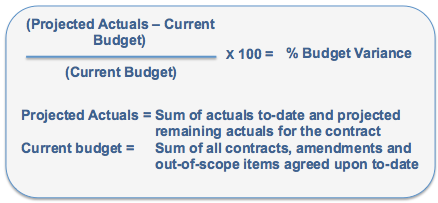MCC Metric of the Month Blog: Percentage Budget Variance
Let's look at a valuable cost metric: percent variance from budget.
MCC has 100 different metrics relating to clinical trials, from timeliness and cycle time metrics to quality, efficiency and cost metrics. This month, let’s look at a valuable cost metric: percent variance from budget. This particular MCC metric has been developed for Imaging Core Labs, but can easily be applied to any internal, outsourced or vendor situation.
Why this metric is important: Ideally, sponsor and supplier should actively manage the budget, ensuring that actuals match the initial forecast at the end of the contract. This means tracking actuals against forecasted contract budget and "reforecasting" as needed based on usage or when study events require it (e.g. increase in enrollment or change in scope). The goal is to avoid simply adding to the budget when there is a change in scope, but instead find ways to meet budget constraints despite the changing landscape. Suppliers will be more able to accurately project revenue and sponsors will be able to readjust budgets and reallocate spend if the actual spend vs forecast is constantly tracked. This requires support from both the sponsor’s and supplier's finance and project management groups to track, evaluate, reconcile, and then reforecast based on study information. Success also requires support from the sponsor in terms of timely reforecasting and information dissemination to the supplier.
Definition: Percent budget variance is the percent difference between the current actual spend and the current contracted value (including change orders and pass through costs) during the life of a project and at the completion of the contract. The variance as calculated here can be either positive or negative.
How to calculate this metric: The formula is simply the % variation of actuals vs. the current contracted budget upon completion of the study. However, the calculation is a bit more complex. At any given point, the actual cost projected to the end of the contract must be compared to the latest budget, including all contracts, amendments and out-of-scope items agreed upon to date. To do this, on a quarterly basis:
- First, calculate the total current budget, by summing all contracts, amendments and out-of-scope items agreed upon to-date.
- Then calculate the total projected actuals, by summing the actuals invoiced to date and the projected remaining actuals to the end of the contract.
- Finally, subtract the total current budget from the total projected actuals, then divide the result by the total current budget and multiply by 100.

The variance should be measured at least quarterly (monthly is better for identifying incipient problems that will create big variances later) and then at contract end. A variance of <5% is Optimal, while a variance of 5-10% is Satisfactory.
What you need in order to measure this: You need the following three things at the end of each quarter: the total actual billings to date, a current forecast of the projected actuals to the end of the project, and a current budget forecast to the end of the contract, including the original contract, amendments and out-of-scope items agreed upon to date.
What makes performance on this metric hard to achieve: This metric has two difficult aspects: your contracts, finance and project management groups have to be on top of the contract, updating forecasts and actuals on a regular basis, and sponsor and supplier have to maintain good communications and cooperation so that both parties are aware of all the current factors that could result in contract changes and amendments as well as potential overruns and ways to manage the underlying problems.
Things that you can do to improve performance: Once you are tracking the cost variance, regular measurement and tracking will allow both organizations to quickly see when the work is deviating from forecast and take corrective action. This in turn allows project mangers to implement early, corrective actions and risk mitigation plans that can bring actual costs back into line with forecasts. Hence, regular reviews of this metric by project managers can lead to much more effective and accurate forecasting and execution.
Companion metrics: Other metrics that you should consider in tandem with this metric include: (1) Schedule Compliance Metrics and (2) Quality Metrics. Schedule compliance metrics ensure that your actuals aren’t looking good simply because the actual work is lagging the forecasted work. Quality metrics ensure that budgets are not being met by compromising quality.
Example: In the graph below, we’ve plotted % variance as a function of contract month. During the first three months, actuals track exactly to budget. However, starting in Month four we see a startling growth in actuals vs budget, rising to a 15% variance (overrun) by Month six. Projections by project management and finance show continued growth in the variance to 22% and then remaining flat to the end of the contract. Project management at the imaging core lab has been watching this growth and communicating to sponsor project managers, who have traced the variance growth to an amendment that is driving more reads by the vendor than anticipated. A contract amendment in Month six remedies this and the variance resets to zero. However, in Month 10 the variance begins to grow again and is expected to reach 15% by the end of the contract. This spurs managers in both organizations to re-examine the number of reads to determine the cause of the variance.

Dave Zuckerman, CEO, Metrics Champion Consortium, [email protected]
Linda Sullivan, COO, Metrics Champion Consortium, [email protected]